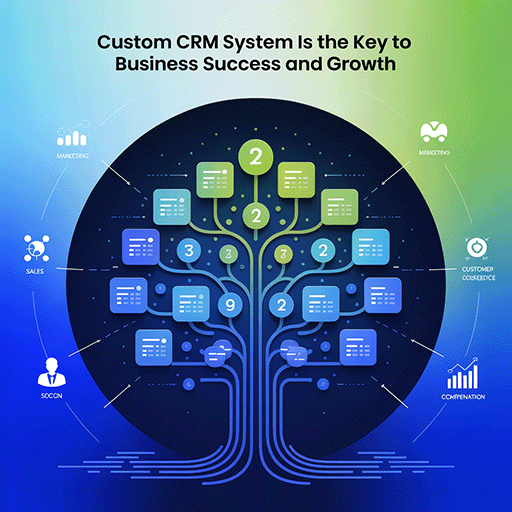In the fast-evolving healthcare landscape, EHR (electronic health record) software development is a game-changer for businesses. It aims to streamline operations and enhance patient care. Small and mid-sized healthcare providers, as well as startups, see the need to adopt robust electronic health record software to stay competitive. Indeed, more than 95% of non-federal acute care hospitals in the United States have implemented certified EHR systems. This underpins that companies not only want to keep up with their competitors but that the software is extremely helpful.
However, understanding how to build an EHR system from the ground up can seem daunting. In this comprehensive guide, we’ll walk you through the EHR development process, from key features to architecture, and ensure you’re fully prepared to embark on your own project.
What is an EHR System?
An EHR system (Electronic Health Record) is a digital platform that stores and manages patients’ medical histories, treatment plans, diagnoses, and other crucial data. Unlike EMR software (Electronic Medical Record), which typically focuses on managing patient data within a single healthcare facility, an EHR system makes it easy to share patient data across different providers. Consequently, an EHR fosters better-coordinated care. This is also one of the most used medical software programs in healthcare. Read our blog to explore others.
From $26.84 billion in 2019, the worldwide electronic health records market is set to expand, reaching an estimated $39.35 billion by 2027. This growth reflects the increasing digitization of healthcare systems globally, a trend expected to persist.
Types of Electronic Health Record (EHR) Software
Understanding the different types of EHR software can help you choose or develop the right system for your healthcare organization:
-
Cloud-Based EHRs: A popular option due to lower upfront costs, which offers flexibility in access and easy scalability.
-
On-Premise EHRs: Provides more control over data security, though they come with higher initial setup and maintenance costs.
-
Ambulatory EHRs: Target smaller practices or outpatient services while focusing on specific workflows.
-
Specialty-Specific EHRs: Tailored to the unique needs of specialized medical fields such as cardiology or dermatology.
Why Adopt EHR?
Healthcare providers increasingly realize the benefits of adopting EHR software:
-
Improved Patient Care: Access to accurate, up-to-date patient records leads to better decision-making and personalized treatment.
-
Enhanced Efficiency: Administrative tasks such as appointment scheduling, billing, and medical charting become much more streamlined.
-
Regulatory Compliance: Systems developed with EHR software development requirements ensure adherence to security and privacy laws like HIPAA.
-
Data Accessibility: EHR systems must have well-designed and well-organized interfaces to allow easy access to patient data from anywhere.
EHR System Architecture
A well-structured EHR system development requires careful consideration of its architecture. A typical EHR system includes three main layers:
-
Database Layer: Stores large amounts of structured and unstructured medical data, from patient records to billing information.
-
Application Layer: Implements the business logic for managing medical workflows, such as diagnosis and treatment planning.
-
User Interface (UI) Layer: A user-friendly interface ensures that healthcare providers can quickly access and input patient data without technical challenges.
Expert EHR developers focus on ensuring these layers are both scalable and secure while maintaining compliance with healthcare regulations.
Basic Features of EHR Software
Any EHR development project should prioritize the following must-have features:
-
Patient Data Management: The heart of every EHR system, this feature allows healthcare professionals to access and update patient records.
-
E-Prescribing: Streamlines the process of prescribing and sending medications to pharmacies electronically.
-
Billing and Claims: Integration with medical billing systems is essential for managing payments and insurance claims.
-
Interoperability: A key to electronic health record development, which allows your system to seamlessly communicate with other healthcare platforms.
-
Security: EHR software requirements include strict compliance with privacy laws and regulations such as HIPAA, ensuring patient data is protected.
Team Required to Build an EHR Software
Building an EHR system requires a multi-disciplinary team to handle everything from EMR design to EHR software implementation. Key team members include:
-
Project Manager: Oversees the development process and ensures all timelines are met.
-
UI/UX Designers: Build user-centric interfaces that optimize workflows for healthcare providers.
-
Software Developers: Build both the front-end and back-end of the system, ensuring smooth performance.
-
QA Engineers: Test the system for security, functionality, and compliance with healthcare standards.
-
Compliance Experts: Ensure that the software adheres to legal and industry-specific regulations.

How to Build an EHR System
Building an EHR system is a complex yet rewarding process, especially when tailored to the unique needs of your healthcare practice. Below is an in-depth, step-by-step guide to help you understand each phase of EHR software development. Whether you’re starting from scratch or upgrading an existing system, this detailed process ensures you cover all the necessary components for a successful implementation.
Step 1. Requirement Gathering and Analysis
The first step in EHR system development is thoroughly understanding your healthcare facility’s or organization’s needs and requirements. To do this, you need to collaborate with stakeholders such as healthcare providers, administrative staff, IT personnel, and compliance officers. This way, you’ll pinpoint essential features and workflows the EHR system must support.
Key activities:
-
Conduct interviews with doctors, nurses, and other healthcare staff to understand their pain points and daily workflows.
-
Define the critical functionalities you need, such as patient data management, billing, reporting, and interoperability with other healthcare systems (labs, pharmacies, etc.).
-
Identify specific EHR software requirements related to compliance (e.g., HIPAA in the U.S.) and security standards.
-
Map out user roles and access levels to ensure data privacy and control.
Output: A detailed document that covers all the functional and non-functional needs, user stories, and system limits.
Step 2. Designing the System Architecture
Once the requirements are clearly defined, the next step is to design the EHR system architecture. This phase lays the foundation for how the system functions, scales, and handles data. The architecture must be secure, scalable, and designed for interoperability with other healthcare platforms.
Key activities:
-
Design the data storage system: Choose between SQL databases (for structured data) and NoSQL databases (for unstructured or semi-structured data). Consider whether the system will be hosted on-premise or in the cloud.
-
Plan the application layer: This layer should handle business logic like scheduling, billing, patient data management, and reporting. Define how data flows between different system components.
-
Develop the user interface (UI) design: UI/UX designers should create wireframes and mockups to ensure the system is intuitive for all users.
-
Ensure interoperability: Your EHR must be able to communicate with external systems, such as laboratory information systems, radiology information systems, and pharmacies, through standardized protocols like HL7 or FHIR.
-
Focus on security architecture: Incorporate security measures such as data encryption, multi-factor authentication (MFA), and access controls to ensure compliance with regulatory standards and protect sensitive patient data.
Output: Wireframes, mockups, and detailed architectural blueprints that map out the system’s structure, workflows, and data flows.
Step 3. Selecting Technology Stack
Choosing the right technology stack is vital for long-term scalability, performance, and security. A solid tech stack can also reduce future development and maintenance costs.
Key technologies to consider:
-
Frontend technologies: Angular, React, or Vue.js for creating responsive and user-friendly interfaces.
-
Backend technologies: Node.js, Python, Django, Java, or Spring for building scalable server-side applications.
-
Database: PostgreSQL or MySQL for relational databases or MongoDB for NoSQL databases, depending on the data type.
-
Cloud infrastructure: AWS, Microsoft Azure, or Google Cloud for hosting scalable cloud-based EHR systems.
-
Security: Implement SSL/TLS protocols for encrypted communication and OAuth for secure API authentication.
Output: A finalized tech stack that supports your system’s performance, scalability, and security requirements.
Step 4. Development of Core Features
This is where the EHR system coding happens, based on the requirements and architecture already laid out. Breaking development into smaller chunks—like sprints—is a good way to go, following the Agile approach. This helps ensure things get done on time and that quality stays high.
Core features to develop:
-
Patient Management: The ability to create, update, and manage patient records, including demographics, medical history, and contact information.
-
Scheduling and Appointments: Implement a calendar system for managing patient appointments, doctor schedules, and reminders.
-
Clinical Documentation: Build forms for capturing patient visits, diagnoses, and treatment plans in a structured way.
-
E-Prescribing: Enable healthcare providers to send prescriptions to pharmacies electronically with built-in drug-drug interaction checks.
-
Billing and Invoicing: Integrate a medical billing system that supports insurance claims, patient invoicing, and payment tracking.
-
Lab Integration: Allow lab results to automatically populate in a patient’s health record, with real-time notifications for doctors when results are ready.
-
Interoperability: Ensure your system can exchange data with external systems through standardized protocols like HL7, FHIR, and DICOM for imaging.
-
User Roles and Permissions: Implement access control mechanisms to ensure that only authorized personnel can view or modify sensitive data.
Output: A functional EHR system prototype with core features ready for testing and validation.

Step 5. Testing and Quality Assurance
Thorough testing is critical to ensuring the EHR system is stable, secure, and compliant. During this phase, your Quality Assurance (QA) team should run a variety of tests, from functionality checks to security assessments. Our QA team can help you catch issues early. Click here to read more about our QA services.
Types of tests to conduct:
-
Unit Testing: Verify that individual components of the system (such as patient data entry forms) work correctly.
-
Integration Testing: Ensure that different modules (e.g., patient management and billing) work together seamlessly.
-
Security Testing: Test for vulnerabilities, data breaches, and compliance with regulatory standards like HIPAA.
-
Usability Testing: Work with healthcare providers to test the system’s interface, ensuring it is user-friendly and intuitive for daily use.
-
Performance Testing: Ensure the system can handle large volumes of data and user traffic without slowing down or crashing.
Output: A thoroughly tested EHR system that is ready for deployment and has passed all functional and security checks.
Step 6. Deployment and Integration
After testing, it’s time to deploy the EHR system. Set up the system in the production environment, configure any integrations, and migrate data from legacy systems if applicable.
Key activities:
-
Data migration: Transfer existing patient records from legacy systems into the new EHR, ensuring data integrity.
-
Integration setup: Make sure that the system is fully integrated with third-party applications such as lab management, pharmacy systems, and billing software.
-
Server configuration: Set up cloud or on-premise servers to host the system and guarantee scalability and data redundancy.
Output: A live EHR system ready for use by healthcare professionals.
Step 7. Training and User Onboarding
The success of any EHR software implementation depends heavily on user adoption. A system is only as good as those who know how to use it. At this stage, medical and administrative staff need in-depth training to get the most out of it.
Training should cover:
-
Navigating the interface: Teach users how to log in, manage patient records, schedule appointments, and access lab results.
-
Data entry: Provide training on how to input data correctly and efficiently, including the use of templates for clinical documentation.
-
Security protocols: Educate users on password management, multi-factor authentication, and data access controls to ensure compliance.
-
Error reporting: Train staff on how to report bugs or issues they may encounter during daily use, ensuring continuous improvement of the system.
Output: A trained healthcare staff that is comfortable using the EHR system, with all departments fully onboarded.
Step 8. Post-Launch Support and Maintenance
Even after a successful launch, your EHR development journey doesn’t end. Continuous support and maintenance are essential for addressing bugs, improving performance, and keeping the system compliant with evolving healthcare regulations.
Ongoing activities:
-
System updates: Regularly update the software with new features or patches for security vulnerabilities.
-
Performance monitoring: Monitor the system to ensure optimal performance, particularly during high-traffic periods.
-
Regulatory updates: Ensure your system stays compliant with healthcare regulations by implementing necessary updates to security protocols and reporting standards.
-
User feedback: Collect feedback from users to identify potential areas for improvement and additional feature development.
Output: A well-maintained EHR system that evolves with your healthcare practice’s needs and guarantees long-term functionality and security.
By following these detailed steps, you can ensure a smooth and efficient EHR system development process. From requirement gathering to post-launch support, each stage is crucial to building a secure, compliant, and user-friendly EHR solution.
If you’re considering building your own EHR system, partnering with an experienced EHR developer like LITSLINK can ensure you meet all your needs while navigating the complexities of healthcare software development.
What are the Benefits of Developing Your Own EHR Software?
|
Developing custom EHR software has several advantages:
|
When it comes to healthcare technology, off-the-shelf solutions may not always meet the unique demands of your practice. Building custom EHR software provides a range of benefits that go beyond simply digitizing medical records.
Here’s a breakdown of the key advantages.
Full Customization for Unique Workflows
A custom EHR system fits your healthcare practice’s unique workflows. Every provider has different processes and needs. Off-the-shelf EHR systems often don’t meet those needs. For example, a cardiology clinic needs custom templates for heart conditions and treatments. By building your own EHR software, you can customize everything to fit your practice’s needs.
Increased Control Over Features and Updates
A custom-built EHR system gives you full control over the features and functionalities. You can add, modify, or remove any component as your practice evolves without relying on third-party vendors for updates or changes.
A small healthcare clinic may initially require basic patient management features but, as it expands, may need advanced functionalities like telemedicine integration or AI-powered diagnostics. A custom EHR system can develop and integrate new features as needed. It won’t be limited by third-party software updates.
Enhanced Compliance and Data Security
Healthcare organizations must adhere to stringent regulations like the Health Insurance Portability and Accountability Act (HIPAA) in the U.S. or the General Data Protection Regulation (GDPR) in Europe. Off-the-shelf EHR systems often provide basic compliance features. By developing custom software, you can ensure top-notch data security that exceeds regulatory standards.
Seamless Integration with Existing Systems
Many healthcare providers rely on various specialized tools for billing, diagnostics, lab management, and patient scheduling. Off-the-shelf EHR systems may not always integrate smoothly with these existing tools, causing inefficiencies and potential data loss.
A healthcare organization using an external billing system like QuickBooks may find integrating it seamlessly with a generic EHR platform challenging. On the other hand, a custom-built EHR system can be developed with these integrations in mind, ensuring seamless communication between systems.
Improved Long-Term Cost Efficiency
While the upfront cost of developing a custom EHR system may be higher than purchasing a ready-made solution, the long-term cost benefits often outweigh this initial investment. Licensing fees for third-party software, recurring upgrade costs, and additional charges for customization can quickly add up, making off-the-shelf EHR solutions more expensive over time.
By building a custom system, healthcare providers can achieve significant cost savings: 28% on transcription, 78% on billing errors, and 34% on adverse drug events.
Better User Experience and Higher Adoption Rates
One of the main reasons healthcare providers resist adopting new EHR systems is the steep learning curve. New systems usually come with unfamiliar interfaces and workflows. Custom EHR software development allows you to design an intuitive interface that aligns with your healthcare team’s workflow, resulting in better user adoption and overall satisfaction rate.
Providing a user-friendly experience reduces the risk of burnout among healthcare staff and ensures smoother adoption across your organization. In a survey of doctors and nurses, nearly 63% of respondents admitted feeling pretty burned out at work.
Pitfalls of an EHR System Integration
|
Although the benefits are significant, integrating a new EHR system comes with challenges:
|
Understanding the pitfalls of an EHR system helps healthcare providers prepare for and mitigate potential issues. Below are the most common pitfalls of EHR system integration and how they can impact healthcare organizations.
High Initial Costs and Resource Allocation
Integrating a new EHR system, especially a custom-built one, requires a significant financial and resource investment upfront. The costs associated with purchasing or developing the system, training staff, and ongoing support can strain a healthcare organization’s budget, particularly for smaller businesses or startups. These costs can easily range from $50,000 to over $500,000, depending on the complexity of the system and the size of the practice. As a business owner, explore 15 innovative healthcare business ideas that will revolutionize how we approach health and wellness in the digital era.
Complex Integration with Existing Systems
One of the most challenging aspects of EHR system integration is ensuring compatibility with existing healthcare systems and applications, such as lab information systems (LIS), pharmacy systems, or billing platforms. Poor integration can result in data silos, where critical information is stored in isolated systems that don’t communicate with each other. This leads to inefficiencies, higher error rates, and lower quality of care.
Data Migration Challenges
Migrating existing patient data from legacy systems to a new EHR system is a complex and time-consuming process. Inaccuracies or gaps in data migration can lead to incomplete patient records, missing historical data, and potential risks to patient care. Data migration issues can result in the loss of critical patient information and even regulatory non-compliance if historical data is required for audits or legal purposes.
Training and User Adoption
Even the most advanced EHR systems will fail if the staff who use them daily are not adequately trained. Training healthcare providers and administrative staff to use a new EHR system is essential for successful adoption, but it can also be a significant challenge, particularly in busy healthcare environments.
Downtime and Disruptions During Transition
Transitioning from a legacy system or paper records to a new EHR system can disrupt daily operations, particularly if the new system requires downtime during deployment or if staff struggle with the initial learning curve. Any downtime can cause delays in patient care, increase wait times, and put additional strain on healthcare providers.
Data Security and Compliance Concerns
Although EHR systems are designed to improve data security, the integration process introduces new risks if not properly managed. Ensuring the new system complies with data privacy regulations like HIPAA, GDPR, or regional healthcare laws is crucial to avoid breaches or fines.

Estimating the Cost of an EHR Software Development
The cost of EHR software development depends on several factors, including project complexity, customization, compliance, and data migration needs. Here’s a brief breakdown:
-
Small Clinic: Basic EHR systems range from $50,000 to $100,000, covering essential features like patient management and billing.
-
Medium-Sized Practice: Costs typically fall between $100,000 and $300,000, incorporating more advanced functionalities like lab integrations and custom templates.
-
Large Hospitals: Complex systems with features like telemedicine or AI can exceed $500,000.
Additional costs include compliance with regulations (e.g., HIPAA), data migration, staff training, and ongoing maintenance, which typically runs at 15-20% of the initial development cost annually.
Try Our Free Online Calculator
To make it easy for you to estimate the cost of your custom EHR system, we offer a free online calculator. By answering a few questions about your practice and required features, you can get an instant estimate tailored to your needs—completely free.
LITSLINK as an EHR Software Developer
If you’re looking for an experienced EHR developer, look no further than LITSLINK. With a track record of building high-quality healthcare software, we understand the nuances of EHR software development and can help you create a solution that meets your specific requirements. From design to implementation, our team of experts can guide you through every step of the development process. We also know full well how to deal with all the pitfalls that pop up when building your custom EHR software. Want to find out how? Hit us up!
To Sum Up
As the healthcare industry continues to embrace digital transformation, EHR software development offers unparalleled benefits for improving patient care, streamlining workflows, and enhancing regulatory compliance. For small to mid-sized healthcare businesses and startups, building a custom EHR system is a strategic investment that can improve efficiency and patient outcomes.
Ready to start your EHR system development journey? Contact us today and let our team help you bring your vision to life!





